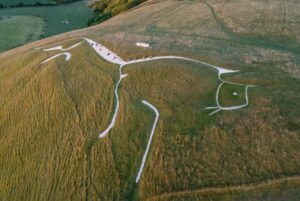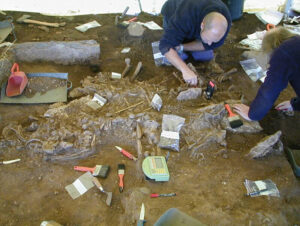Is it possible that the biblical city of Sodom has finally been found? Archaeologists with Veritas International University and Trinity Southwest University made a breakthrough discovery in Tall el-Hammam, an ancient site located between Lake Tiberius and the Dead Sea in Jordan. Evidence suggests that a cosmic event likely destroyed the city. It bears striking similarities to the destruction of Sodom in Genesis.

Artist’s depiction of a cosmic airburst. Photo: Allen West and Jennifer Rice
Before the event, Tall el-Hammam was a bustling and populous city of over 8,000 residents. Water was plentiful. The city had a large palace complex, military fortifications, houses, and high walls. It covered 34 hectares, making it seven to eight times larger than Jerusalem and neighboring Jericho. It was the most impressive city in the southern Levant.
For 600 years, that area was abandoned
Then suddenly, some mysterious event caused a 600-year gap in the city’s archaeological records. What happened?
Researchers determined that a catastrophic event occurred in 1650 BCE, during the Middle Bronze Age. They analyzed the site in several layers: the debris matrix, blow-over layer, dark layer, and destruction layer. Then they further categorized the findings according to the time period.
They uncovered evidence of a “high-temperature burning of the city”, including melted or bubbled pottery shards, clay, bricks, iron, titanium, and many other materials. The pottery shards bore a lingering magnetic characteristic. Scientists used X-ray spectroscopy, electron diffraction, electron microscopy, and differential scanning calorimetry to make these determinations.

‘Lot and his daughters’ (1520). Painting: Lucas van Leyden
What startled scientists the most was the presence of shocked quartz (fractured quartz grains) and diamondoids, two materials associated with cosmic impacts. High temperatures and pressures can “pyrolyze” plant life and carbonated rocks, thus solidifying them and transforming them into diamond-like materials. The quartz needed a pressure of five billion pascals (725,000 pounds per square inch) to be shocked. They also found charred human remains. The event had to have been over 2000 ℃ to cause such damage.
Other theories
While wildfires, fires from warfare, earthquakes, and volcanism were theories on the table, they were not pursued. They found objects like arrowheads and sling stones and dated them to the Iron Age rather than the Middle Bronze Age. No military weapons or devices turned up in the Middle Bronze Age strata, which rules out warfare.
The city lies near the boundary between the Arabian and African Plates and is prone to earthquakes. However, the overwhelming evidence of high temperatures suggests that it wasn’t just an earthquake.

Extent of the airburst in a similar event that struck Russia in 1908. Photo: Phil Silvia
The most likely explanation is a “cosmic airburst”, where a comet or meteor falls to Earth at high velocity, explodes in mid-air, and creates a powerful shock wave on the Earth’s surface.
The buildings of Tall el-Hammam were completely flattened and driven into the ground, similar to what happened in Russia’s Tunguska event of 1908, but possibly even more powerful. Since there is no crater, an airburst is the leading theory.
Was it a meteor?
If true, the meteor was traveling at 61,000kph and exploded four kilometres above the city. The resulting shock waves would have wiped out everything and may have caused the Dead Sea to throw salt into the air. This would explain the puzzlingly high saline content of the surrounding soil.
Archaeologists believe the impact was 1,000 times more destructive than an atomic bomb. It also affected the town of Jericho, 22km away. Six centuries after the event, resettlement began.
The burning question is, “Is this the Sodom from the Bible?” In Genesis, God destroyed Sodom for its sinful ways with “sulfur and fire”. Some believe it was an earthquake or volcanic eruption, yet many paintings depict meteor strikes. It is possible that a survivor of the catastrophe recounted it to others until it eventually found its way into the Old Testament. Nevertheless, archaeologists have not made it a top priority to prove that it is that biblical city.






